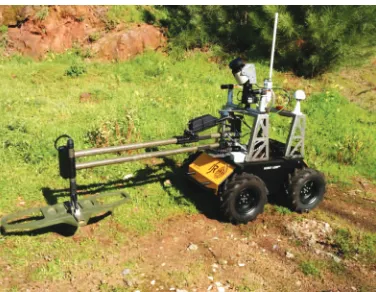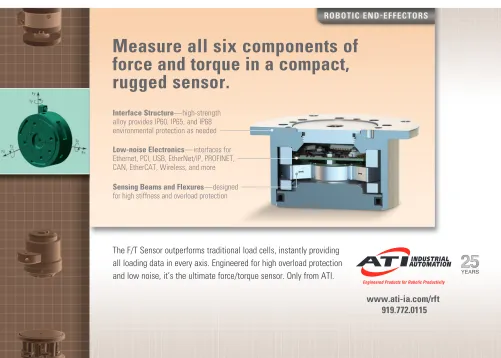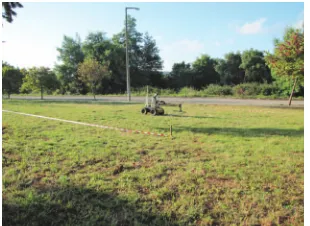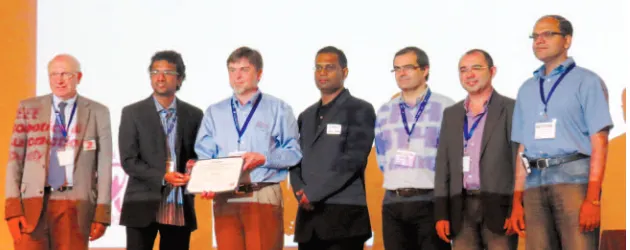HUMANITARIAN TECHNOLOGY
10
Novel Techniques to Solve
Space-Exploration Problems
By Name name, affliation; Name name, affliation;
• IEEE ROBOTICS & AUTOMATION MAGAZINE • SEPTEMBER 2014
2014 Humanitarian Robotics and Automation
Technology Challenge
By Raj Madhavan, Lino Marques, Edson Prestes, Prithviraj Dasgupta, Gonçalo Cabrita, David Portugal, Bruno Gouveia, Vitor Jorge, Renan Maffei, Guilherme Franco, and Jose Garcia
R
obotics and automation (R&A) technologies have the potential to transform and improve the lives of people around the globe by addressing the world’s toughest chal-lenges. The IEEE Robotics and Automa-tion Society (RAS) Special Interest Group on Humanitarian Technology (SIGHT) is engaging the academic and nonacademic community to propose viable solutions in R&A to address relevant world problems through the Humanitarian Robotics and Automation Technology Challenge (HRATC). The HRATC is an unprece-dented opportunity for IEEE Members from around the world to collaborate using their skills and education to benefit humanity. The problems (challenges) are framed with the environmental, cultural, structural, political, socioeconomic, and resource constraints so that solutions can be developed, deployed, and sustained.RAS is the first and only IEEE Society to have a SIGHT. The mission of the RAS SIGHT is the application of R&A tech-nologies for promoting humanitarian causes around the globe and to leverage existing and emerging technologies for the benefit of humanity and toward increasing the quality of life in under-served, underdeveloped areas in collabo-ration with existing global communities and organizations.
According to the United Nations Mine Action Service, land mines kill 15,000–20,000 people every year (most-ly children) and maim countless more across 78 countries. Demining efforts
cost US$300–1,000 per mine, and, for every 5,000 mines cleared, one person is killed and two are injured. Thus, clearing postcombat regions of land mines has proven to be a difficult, risky, dangerous, and expen-sive task with enormous so-ci a l implic at ions for civilians. Motivated by these considerations, the first HRATC edition took place at the 2014 International
Conference on Robotics and Automa-tion (ICRA) in Hong Kong and remote-ly in Coimbra, Portugal. It focused on promoting the development of new strategies for autonomous land mine de-tection using a mobile (ground) robot.
Initially, 14 teams from eight countries submitted their entries. Based on the de-scription papers where teams were asked to describe their experience and strate-gies, ten teams were short-listed to move forward with the three stages of HRATC 2014: simulation, testing, and finals. The 2014 edition was the first HRATC event where teams from around the globe had the chance to participate and remotely develop autonomous demining strategies for detection and classification in a physi-cal outdoor robotic platform, the field and service robotics (FSR) Husky, as shown in Figure 1. This is an all-terrain, four-wheeler, skid-steering autonomous robot built around a Clearpath Husky A200 base, comprising several sensors, such as stereo cameras, a laser range find-er, a global positioning system (GPS), an inertial measurement unit (IMU), and a
two-degrees-of-freedom (2-DoF) mine clearance arm equipped with a Vallon VMP3 metal detector.
For the simulation stage (March– April 2014), a software framework (hereafter referred to as the HRATC framework) that runs on a Linux-based operating system and uses the robot op-erating system (ROS) to communicate with the client and the robot was devel-oped. Figure 2 presents the software ar-chitecture. In the simulation, as shown in Figure 2(a), the framework provides the simulated data to the client. The Ga-zebo Simulator, through the Husky modules, provides the data of the robot sensors, cameras, and its localization, while a custom simulator provides the metal detector readings based on data sets collected with the real metal detec-tor. In the core of the framework is the HRATC Judge, which extracts several performance measures, such as the number of detected mines, false detec-tions, and exploded unknown mines as well as the covered area and cover-age time, and computes the scores of Digital Object Identifier 10.1109/MRA.2014.2334953
Date of publication: 10 September 2014
12 • IEEE ROBOTICS & AUTOMATION MAGAZINE • SEPTEMBER 2014
the teams. During experiments, these measures can be visualized in the HRATC framework main window, as
shown in Figure 3, along with some additional information, such as the robot path.
The scoring metric used to evaluate the performance of the teams is a compo-sition of three different components: the mine detection score, the total time score, and the swept area score. The mine
detec-tion score—the one with the largest weight of the three—is a ratio between the number of true detections and all guesses made by the competitor, and, therefore, each mistake decreases this score. In addi-tion, mistakes considering previous knowledge (e.g., explosions of detected mines) are worse than mistakes without
Gazebo Simulator hratc_framework
hratc_framework (a)
(b) Metal Detector
Simulator ROS Ecosystem
fsr_husky_robot
ROS Ecosystem Client
ROS Node 1
Client ROS Node 2 (f)
Client ROS Node 1
Client ROS Node 2 (f)
HRATC Judge
HRATC Judge
Figure 2. The software architecture for (a) the simulation and (b) the testing phase.
Figure 3. An HRATC framework main window.
Measure all six components of
force and torque in a compact,
rugged sensor.
www.ati-ia.com/rft 919.772.0115
ROBOTIC END-EFFECTORS
Low-noise Electronics—interfaces for Ethernet, PCI, USB, EtherNet/IP, PROFINET, CAN, EtherCAT, Wireless, and more
Interface Structure—high-strength alloy provides IP60, IP65, and IP68 environmental protection as needed
Sensing Beams and Flexures—designed for high stiffness and overload protection
While the world benefi ts from what’s new,
IEEE can focus you on what’s next.
Request a Free Trial
www.ieee.org/tryieeexplore
Develop for tomorrow with
today’s most-cited research
.
Over 3 million full-text technical documents can power your R&D and speed time to market.
• IEEE Journals and Conference Proceedings • IEEE Standards
• IEEE-Wiley eBooks Library • IEEE eLearning Library
• Plus content from select publishing partners
IEEE
Xplore
®Digital Library
Discover a smarter research experience.
IEEE TRANSACTIONS ON
ROBOTICS
A PUBLICATION OF THE IEEE ROBOTICS AND AUTOMATION SOCIETY
Submission informa-on : h0p://ieee-‐ras.org/publica-ons/t-‐ro
The IEEE TRANSACTIONS ON ROBOTICS (T-‐RO) publishes fundamental scien>fic
papers covering all aspects of robo>cs. Papers repor>ng on results of major
research significance that draw upon any combina>on of theore>cal, algorithmic,
experimental, and empirical analysis and valida>on, including design and fabrica>on,
are welcome. Paper categories include regular papers, short papers,
communica>ons, and survey papers. Mul>media aLachments are also welcome.
ABDERRAHMANE KHEDDAR CNRS-‐AIST JRL
Tsukuba, Japan
TODD MURPHEY Northwestern Univ. Evanston, IL USA
BRAD NELSON ETH Zurich Zurich, Switzerland
CARME TORRAS IRI CSIC-‐UPC Barcelona, Spain ASSOCIATE EDITORS
TAMIM ASFOUR Karlsruhe Inst. Tech. Karlsruhe, Germany
AUDE BILLARD EPFL
Lausanne, Switzerland
JOSE CASTELLANOS Univ. Zaragoza Ritsumeikan Univ. Kusatsu, Japan Minneapolis, MN, USA PATRIC JENSFELT
KTH
Stockholm, Sweden
SANGBAE KIM MIT
Cambridge, MA, USA
JA CHOON KOO Sungkyunkwan Univ. Suwon, Korea
Wessling, Germany
LUCIA PALLOTTINO Univ. of Pisa Pisa, Italy
JAN PETERS TU Darmstadt Darmstadt, Germany STEPHANE REGNIER
ISIR
PHILIPPE SOUERES LAAS-‐CNRS
15
SEPTEMBER 2014 • IEEE ROBOTICS & AUTOMATION MAGAZINE •
prior knowledge (e.g., explosions of unde-tected mines), and recieve a large penal-ization. The swept area score, i.e., the percentage of the total area of the environ-ment covered by the robot sensors, is of great importance since one of the goals in demining is cleaning the largest area. However, its importance is much smaller than the mine detection score because a large coverage without a good mine detec-tion strategy can be useless and even dan-gerous. Finally, the total time score, although important, is not as critical as correct detection and, therefore, only adds a small contribution to the final score.
In the testing stage, as shown in Fig-ure 2(b), the real robot is used through the fsr_husky_robot ROS metapackage. For consistency, in both stages, the same ROS topics are used to publish the data, which means that the code generated by the teams during the simulation stage can also work on the testing stage with-out major modifications. During the testing phase, which took place over the first three weeks of May 2014, each team had the possibility to refine its field cov-erage and mine detection strategies using ROS to control the FSR Husky. Flexibility was a priority, as the participants could make use of all of the robot’s sensors as they saw fit to develop their own algo-rithms. The testing phase took place in an outdoor arena covered by low grass and ditches, as shown in Figure 4. A few surrogate mines, composed of a small plastic box with a metal sphere inside, were buried at a shallow depth, together with other metal debris, e.g., coke cans, metal pieces, and large screws. Three separate trials were allowed (staggered by a week each) for each team to evaluate and adjust their strategy. Participants had access in real time to precise localization
data fed by GPS, IMU, and odometry. In addition, during the trials, a data set for the teams to assess the sensibility of the metal detector over different types of soil was also provided, as well as several ex-amples on how to control the robot and the sweeping arm with the ROS. Feed-back, data sets, and video footage with the robot behavior were sent to all teams
after each trial. This phase was crucial to allow the participants to have a “feel” of the differences between controlling a simulated platform, which they used for development and the real robot used in the finals. These differences mainly were in the localization system and the arm control. Likewise, the testing phase was a fundamental learning process for the
Figure 4. A challenge environment.
SAFFiR (Shipboard Autonomous FireFighting Robot)
— Dr. Dennis Hong
Professor of Mechanical & Aerospace Engineering and Director of RoMeLa (Robots & Mechanism Laboratory) at UCLA
“For our high performance robots,
we need high speed, light weight,
high torque actuators. The only
solution is maxon.”
What drives Dr. Dennis Hong is his quest to create truly humanoid robots that can do useful work. What drives his robots are maxon motors and controllers. Where precision, consistency, and easy integration are critical, maxon pro-vides the intelligent drive systems to bring tomorrow’s designs to life. Learn how we can help you keep your projects moving. Visit us at maxonmotorusa.com.
16 • IEEE ROBOTICS & AUTOMATION MAGAZINE • SEPTEMBER 2014
challenge organization, as it allowed for checking the robustness of the robot in numerous field trials and during long pe-riods of time, as well as optimizing the arm sweeping controlling parameters, carrying out timely replacement of hard-ware and pieces, and assessing weaker points of the platform so as to improve in upcoming trials.
After the testing phase, four teams participated in the finals at ICRA in
Hong Kong, consisting of two runs on 31 May and 1 June, which were video-streamed live over the Internet from Co-imbra, Portugal. The final challenge environment was an open wooded area with a size of 10 # 5 m, as shown in
Fig-ure 4, and delimited by four GPS coordi-nates. The challenge area was marked by plastic tape for visualization purposes, and a virtual fence was deployed to stop the robots from going outside the
chal-lenge area. Five surrogate mines were buried in the field in addition to metal debris. The teams were evaluated ac-cording to the scoring metric on their best run.
Team ORION of the University of Texas at Arlington was declared as the grand winner. The second- and third-place finishers were the Team Geeks of the Square Table (University of Bremen, Germany) and Team USMiners (Uni-versity of Southern Mississippi). Thanks to IEEE SIGHT sponsorship, the three best-ranked teams received a cash prize (US$1,000, US$500, and US$250, re-spectively) together with a certificate and a plaque.
We see this challenge as a multiyear effort at the end of which it is our hope that, with the help of the academic and industrial communities, a sustainable, cost-effective, and meaningful solution would become available to this problem that has plagued several worldwide com-munities for a long while. In the next HRATC edition that will take place dur-ing ICRA 2015 in Seattle, Washdur-ington, we will continue to refine the develop-ment of new strategies for autonomous land mine detection.
In addition, the RAS SIGHT is cur-rently investigating new challenges for the R&A community. If you are interest-ed in participating and/or proposing a challenge, please send an e-mail to raj. [email protected]. Additional infor-mation regarding challenges, deadlines, and a subscription for the next edition will be posted at http://www.ieee-ras.org/ educational-resources-outreach/human-itarian-efforts. The challenge organizers thank Clearpath Robotics, Inc., the FP7-TIRAMISU project (http://www.fp7-ti-ramisu.eu/), the RAS Competitions Committee, and the RAS SIGHT for their support and partnership in organiz-ing HRATC’14.
The HRATC 2014 organizers were Raj Madhavan (chair, RAS SIGHT), Lino Marques (University of Coimbra, Portu-gal), Edson Prestes (Federal University of Rio Grande do Sul, Brazil), and Prithviraj Dasgupta (University of Nebraska-Oma-ha). For more information and details on the challenge and scope, please visit http://www.isr.uc.pt/HRATC2014/.



